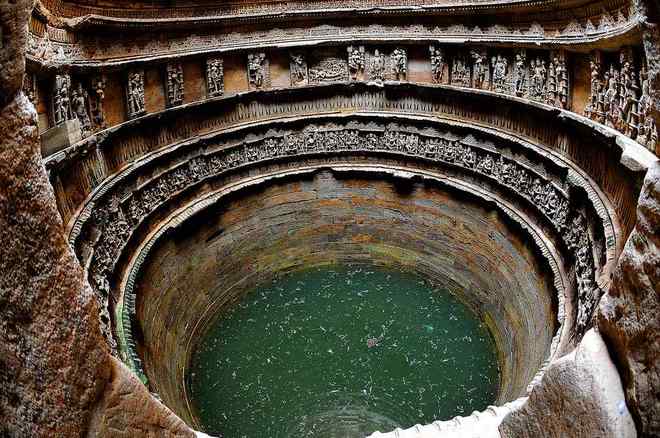A well of India’s royal history
Kanwarjit Singh Kang
In India, water has been an object of worship since time immemorial, not only for its life-sustaining properties but also because of its use in nearly all rituals and ceremonies. That is why step-wells or wells with an underground flight of steps leading down to the level of water were developed in arid regions of western India and Rajasthan centuries ago to collect and store water for drinking, bathing, washing clothes, irrigating crops and also for their use in rituals. Step-wells were called vavs in Gujarati language and in northern India, these were called baolis.
In the earliest step-wells, nothing more than a plain dressed stone protected the sides of the sandy pit, but with the passage of time these step-wells developed into meticulous works of engineering, architecture and art. Its typical example is the marvellous Rani-ki-Vav (Queen’s step-well), an 11th century step-well that survives at Patan in Gujarat. Perceiving its manifold significance, Unesco added it in the World Heritage List last year.
Rani Udayamati built the step-well, Rani-ki-Vav in memory of her husband King Bhimdev (1022-1063). A mention of the construction of this step-well by Rani Udayamati has been made in Prabandha Chintamani written by Merunga Suri in 1304 A.D. It was built at Patan on the banks of Saraswati river. Following the flooding and disappearance of this river due to geotectonic changes, this step-well was buried under layers of silt for nearly seven centuries. In late 1980s, the Archaeological Survey of India exposed the hidden treasure of sculptural and architectural wealth in its original dimension and splendour through careful excavations and removal of silt and debris.
According to the Archaeological Survey of India: “Rani-ki-Vav was built at the height of craftsman’s ability in step-well construction and the Maru-Gurjara architectural style, reflecting mastery of this complex technique and great beauty of detail and proportions. Designed as an inverted temple highlighting the sanctity of water, it is divided into seven layers of stairs with sculptural panels of high artistic quality, more than 500 principal sculptures and more than 1000 minor ones combine religious, mythological and secular imagery, after referencing literary works. The fourth level is the deepest and leads into a rectangular tank at a depth of 23 metres. The well is located at the westernmost end of the property and consists of a shaft, 10 metres in diameter and 30 metres deep.”
Rani-ki-Vav was selected by the Archaeological Survey of India as the site for digital preservation and this monument was scanned over a two-week period in 2011 by the Scottish Ten team and colleagues from the Digital Design Studio at the Glasgow School of Art and experts from CyArk, a non-profit organisation founded by Ben Kacyra, the inventor of 3D scanning system. This group created the 3D digital models of this heritage site, which will help in its proper conservation, restoration and maintenance.
Udayamati’s step-well represents architectural and sculptural monument of human creative genius in its variety of motifs and its elegance of proportions. Preserved with all its key architectural components and, despite missing pavilion stories, its original form and design can still be easily recognised. It was built in Maru-Gurjara temple architectural style, which originated somewhere in the 6th century in and around areas of Rajasthan and Gujarat. Ancient name of Rajasthan was Marudesh while Gujarat was called Gurjaratra. Thus Maru-Gurjara art literally means ‘art of Rajasthan and Gujarat’. Its walls teem with many numerous sculptural images that its architectural form is almost obscure. The full-size sculptures of the stepwell demonstrate the entire Hindu pantheon. The central theme is the Dasavataras, or 10 incarnations of Vishnu, who appeared on earth, each time as a saviour of mankind or as a destroyer of some evil. These incarnations on the earthly scene are known as his avatar, ‘descents’. Sculptures of Vishnu representing him in the form of different 10 avatars are as follows: Matsya, Kurma, Varaha, Narasimha, Vamana, Parsurama, Rama, Krishna, Buddha. Kalki, the last and the 10th incarnation of Vishnu, is yet to come at the end of the present Kali Yuga or Age of Darkness. At the water level of this step-well is a carving of Sheshashayi-Vishnu, in which form Vishnu reclines on the 1000-headed serpent Shesha, where, it is said, he rests in the infinity between ages.
More gracefully carved images depict Shiva, Ganesha, Brahma, Lakshmi, Parvati, Durga, Kubera, Bhairava, Surya and several others accompanied by sadhus and various female figures such as apsaras (nymphs), nagkanyas (mythological serpent women), and yoginis (women who practise yoga). Interestingly, the sculptures of the apsaras showcase the solah-shringar, the 16 different styles of make-ups to make a woman look more attractive. These numerous sculptures harmoniously blend with geometric patterns and sinuous bands of flowers and leaves, glorifying sculptor’s creativity, as well as Rani Udayamati’s initiative and enterprise.









